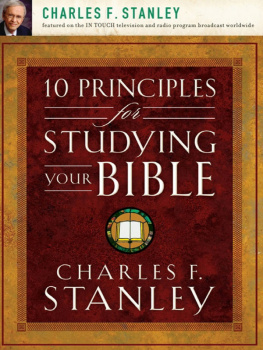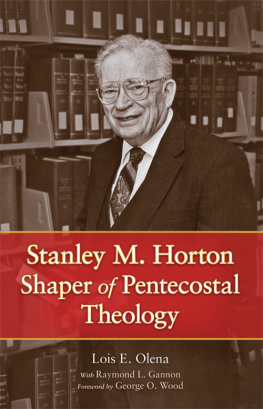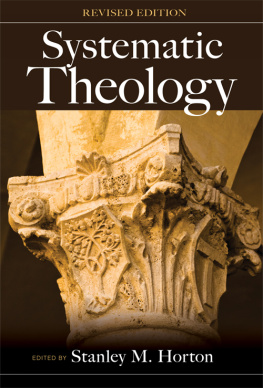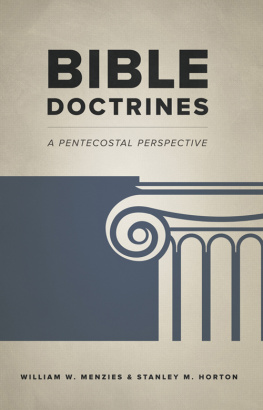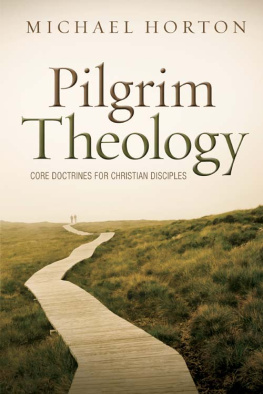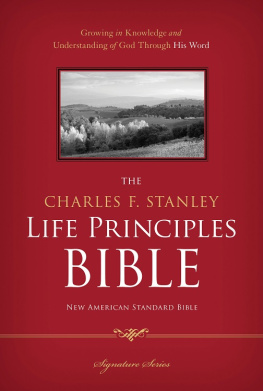Horton Stanley M. - Bible Doctrines: A Pentecostal Perspective
Here you can read online Horton Stanley M. - Bible Doctrines: A Pentecostal Perspective full text of the book (entire story) in english for free. Download pdf and epub, get meaning, cover and reviews about this ebook. year: 2012, publisher: BookMasters, genre: Religion. Description of the work, (preface) as well as reviews are available. Best literature library LitArk.com created for fans of good reading and offers a wide selection of genres:
Romance novel
Science fiction
Adventure
Detective
Science
History
Home and family
Prose
Art
Politics
Computer
Non-fiction
Religion
Business
Children
Humor
Choose a favorite category and find really read worthwhile books. Enjoy immersion in the world of imagination, feel the emotions of the characters or learn something new for yourself, make an fascinating discovery.

- Book:Bible Doctrines: A Pentecostal Perspective
- Author:
- Publisher:BookMasters
- Genre:
- Year:2012
- Rating:3 / 5
- Favourites:Add to favourites
- Your mark:
- 60
- 1
- 2
- 3
- 4
- 5
Bible Doctrines: A Pentecostal Perspective: summary, description and annotation
We offer to read an annotation, description, summary or preface (depends on what the author of the book "Bible Doctrines: A Pentecostal Perspective" wrote himself). If you haven't found the necessary information about the book — write in the comments, we will try to find it.
Bible Doctrines: A Pentecostal Perspective — read online for free the complete book (whole text) full work
Below is the text of the book, divided by pages. System saving the place of the last page read, allows you to conveniently read the book "Bible Doctrines: A Pentecostal Perspective" online for free, without having to search again every time where you left off. Put a bookmark, and you can go to the page where you finished reading at any time.
Font size:
Interval:
Bookmark:
Bible Doctrines
A Pentecostal Perspective
William W. Menzies
and
Stanley M. Horton
Stanley M. Horton, Th.D.
General Editor
ISBN: 978-1-60731-110-2

Springfield, Missouri
This eBook has been enhanced with links that include the full text for most Bible references. Due to file size and performance constraints, references to full chapters or multiple chapters are not linked. References to long passages show only the first fifteen verses. The Bible text is from the New International Version (NIV) translation, used by permission.
Originally published as Understanding Our Doctrine by William W. Menzies . Revised and expanded by Stanley M. Horton.
Unless otherwise indicated, all Scripture quotations are taken from the HOLY BIBLE: NEW INTERNATIONAL VERSION. NIV. Copyright 1973, 1978, 1984 by the International Bible Society. Used by permission of Zondervan. All rights reserved.
1993 by Gospel Publishing House, Springfield, Missouri 65802-1894. All rights reserved. No part of this book may be reproduced, stored in a retrieval system, or transmitted in any form or by any meanselectronic, mechanical, photocopy, recording, or otherwisewithout prior written permission of the copyright owner, except brief quotations used in connection with reviews in magazines or newspapers.
Logion Press books are published by Gospel Publishing House.
Library of Congress Cataloging-in-Publication Data
Menzies, William W.
Bible doctrines: a Pentecostal perspective/William W. Menzies: Stanley M. Horton, general editor.
p. cm.
Rev. and expanded ed. of: Understanding our doctrine.
Includes bibliographical references.
ISBN 0-88243-318-0
1. Assemblies of GodDoctrines. 2. Pentecostal churchesDoctrines. 3. BibleCriticism, interpretation, etc. I. Menzies, William W. Understanding our doctrine. II. Horton, Stanley M. III. Title.
BX8765.5.Z5M46 1993
230.994dc20 9243219
CONTENTS
The study of Bible doctrines is very important, especially in these days when the number of false prophets and false teachers is increasing. Too many Christians are being tossed back and forth by the waves, and blown here and there by every wind of teaching and by the cunning and craftiness of men in their deceitful scheming (). Unfortunately, some believers (perhaps not realizing that doctrine is simply another word for teaching) object to the study of doctrinejust what the propagators of false doctrine would like a person to do. This then makes one a likely candidate for their wind of teaching. Thats why God wants Christians to grow to the point that they know the basic teachings of the Bible. Such knowledge will protect them from false teachers and false doctrine.
The book Understanding Our Doctrine, by Dr. William W. Menzies, was originally written as a unit in a training course entitled Fundamentals for Sunday School Workers. Dr. Menzies, currently president of the Asia Pacific Theological Seminary (formerly Far East Advanced School of Theology) in Baguio, Republic of the Philippines, gave me his kind permission to revise and enlarge his excellent book for general use.
The chapters in the book follow the sixteen points of the Statement of Fundamental Truths, as accepted by the Assemblies of God. Our purpose, however, is not to promote Assemblies of God doctrines, but not bring out the biblical basis and applications of these fundamental Bible truths. Thus, this study will be helpful to those who believe the Bible, whatever their denomination or background. Christians need to know where they stand with respect to Bible doctrines.
Pastors will find the book useful in the training of new converts. Sunday school teachers will find it useful either for course work or as background for their teaching. Bible college students will find it giving them a solid basis for further studies in theology.
I wish to thank Dr. G. Raymond Carlson, general superintendent of the Assemblies of God; The Assemblies of God Theological Seminary; Central Bible College; the Division of Foreign Missions of the Assemblies of God; and others who by their generosity have made this project possible. Special thanks are due also to Glen Ellard and his editorial staff for their expert help.
For easier reading, Hebrew, Aramaic, and Greek words are all transliterated with English letters.
A few abbreviations have been used:
Gk.: Greek
Heb.: Hebrew
KJV: King James Version
NASB: New American Standard Bible
NIV: New International Version
STANLEY M. HORTON, TH.D.
DISTINGUISHED PROFESSOR EMERITUS
OF BIBLE AND THEOLOGY
AT THE ASSEMBLIES OF GOD
THEOLOGICAL SEMINARY
The Assemblies of God came into being as a result of the Pentecostal revival that began early in the twentieth century. This revival came as Gods mighty supernatural answer to Modernism, the antisupernatural religious liberalism that was taking over the major Christian denominations in America and around the world. Books written to defend the faith were being ignored by the seminaries that trained their ministers. The possibility of God-given miracles was denied. A spiritual vacuum was developing. As Dr. William Menzies points out:
The United States in the years between the Civil War and the close of the [nineteenth] century was in social and religious ferment. Moral, political, and economic corruption increased the stresses occasioned by urbanization, industrialization, and immigration. The great denominations, successful in Christianizing the frontier, had become complacent and sophisticated, lacking the vision and vitality to meet the changing needs of a distressed populace. Varying degrees of accommodation to popular ideas, newly imported from Europe, which assaulted orthodox Evangelicalism, further weakened the great communions. Against the erosion in the church world arose the Fundamentalist and Holiness movements. It was largely out of the spiritual concern generated
The current Pentecostal movement traces its origin to a revival at Bethel Bible College in Topeka, Kansas, that began on January 1, 1901. Students, from their studies of the Bible, concluded that speaking in tongues (
The revival became a Pentecostal explosion when, in 1906, W. J. Seymour secured an old two-story frame building at 312 Azusa Street in Los Angeles, California. For about three years services ran almost continually, from ten in the morning to midnight. Many of those who received the Pentecostal baptism in the Holy Spirit there scattered to spread the message. Many independent Pentecostal churches sprang up. Then,
After the Pentecostal outpourings began, numerous publications appeared advocating its teachings and serving as channels for teaching information, and the support of missionaries overseas. One of these publications, the Word and Witness edited by Eudorus N. Bell, issued a call in 1913 for a conference of Pentecostal believers to convene in Hot Springs, Arkansas, the following year. This became the founding meeting of the General Council of the Assemblies of God.
Five basic reasons were given for calling the General Council of April 212, 1914. They were (1) to achieve It was adopted with the following preamble:
This statement of Fundamental Truths is not intended as a creed for the church, nor as a basic of fellowship among Christians, but only as a basis of unity for the ministry alone (i.e., that we all speak the same thing,
The original statement served the Assemblies of God well for many years. There was little dissatisfaction with any of the sixteen points.
The concern for the preservation of doctrinal integrity within the Movement has also resulted in a number of position papers. These papers were called for by ministers of Assemblies of God churches from time to time, as the need for further help and clarification on various subjects was felt on the field. Most of them were prepared by the Commission on Doctrinal Purity, a standing committee appointed by the Executive Presbytery of the Assemblies of God. A number of pastors, district officials, and professors of the Bible colleges and seminary have served on that committee at various times. The papers were approved by the Executive Presbytery and the General Presbytery, the leadership bodies of the Assemblies of God, and then printed. All papers up to 1989 have been collected and published under the title
Next pageFont size:
Interval:
Bookmark:
Similar books «Bible Doctrines: A Pentecostal Perspective»
Look at similar books to Bible Doctrines: A Pentecostal Perspective. We have selected literature similar in name and meaning in the hope of providing readers with more options to find new, interesting, not yet read works.
Discussion, reviews of the book Bible Doctrines: A Pentecostal Perspective and just readers' own opinions. Leave your comments, write what you think about the work, its meaning or the main characters. Specify what exactly you liked and what you didn't like, and why you think so.


